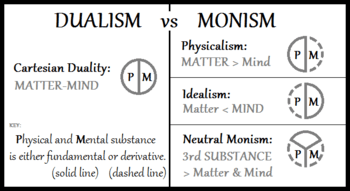Double-aspect theory
In the philosophy of mind, double-aspect theory is the view that the mental and the physical are two aspects of, or perspectives on, the same substance. It is also called dual-aspect monism.[1] The theory's relationship to neutral monism is ill-defined, but one proffered distinction says that whereas neutral monism allows the context of a given group of neutral elements to determine whether the group is mental, physical, both, or neither, double-aspect theory requires the mental and the physical to be inseparable and mutually irreducible (though distinct).[2]

Double-aspect theorists include, among others:
- Baruch Spinoza, who believed that the Existence had two aspects, Extension and Mind, which together were to be taken as two of an infinite set of attributes comprising God (or, Nature).
- There is a dual-aspect interpretation of Immanuel Kant's noumenon.
- Arthur Schopenhauer, who considered the fundamental aspects of reality to be Will and Representation.[3]
- David Bohm, who used implicate and explicate order as a means of displaying dual-aspects.
- Bertrand Russell
- Gustav Fechner
- George Henry Lewes
- Carl Gustav Jung
- Wolfgang Pauli
- John Polkinghorne
- Brian O'Shaughnessy on the dual aspect theory of the Will
- Thomas Nagel.[4]
- David Chalmers, who explores a double-aspect view of information, with similarities to Kenneth Sayre's information-based neutral monism.
- Christopher Langan, whose metaphysical theory called "CTMU" describes reality as self-dual (instead of dualistic) and self-contained "language". In the CTMU theory, the structure of this language is a "global (...) superposition of mind and physical reality".[5]
Pauli-Jung conjecture
From the work of Wolfgang Pauli and Carl G. Jung results a philosophical approach, which Harald Atmanspacher titles the Pauli-Jung conjecture, of dual-aspect monism which has a very specific further feature, namely that different aspects may show a complementarity in a quantum physical sense. That is, the Pauli-Jung conjecture implies that with regard to mental and physical states there may be incompatible descriptions of different parts that emerge from the whole.[6] This stands in close analogy to quantum physics,[6] where complementary properties cannot be determined jointly with accuracy.
Atmanspacher further refers to Paul Bernays' views on complementarity in physics and in philosophy when he states that "Two descriptions are complementary if they mutually exclude each other, yet are both necessary to describe a situation exhaustively."[7]
See also
Notes
- Harald Atmanspacher; Christopher A. Fuchs (23 June 2014). The Pauli-Jung Conjecture and Its Impact Today. Andrews UK Limited. p. 182. ISBN 978-1-84540-759-9.
- Leopold Stubenberg. "Neutral Monism and the Dual Aspect Theory". Stanford Encyclopedia of Philosophy.
- Stanford Encyclopedia of Philosophy: Schopenhauer
- Nagel, T. The View from Nowhere, Chapter III p28
- Quote: "In the Pauli-Jung Conjecture these manifest aspects can even be incompatible or complementary, a feature that is not part of any other dual-aspect approach today. The possibility of incompatible descriptions of parts emerging from wholes clearly drives from Pauli's knowledge of this key concept of quantum theory, and it suggests that structural elements of quantum theory may elucidate our understanding of the psychophysical problem." Cited from: Harald Atmanspacher; Christopher A. Fuchs (23 June 2014). The Pauli-Jung Conjecture and Its Impact Today. Andrews UK Limited. pp. 1 ff. ISBN 978-1-84540-759-9.
- Harald Atmanspacher (2012). "Dual-Aspect Monism à la Pauli and Jung". Journal of Consciousness Studies. 19 (9–10): 96–120(25)..